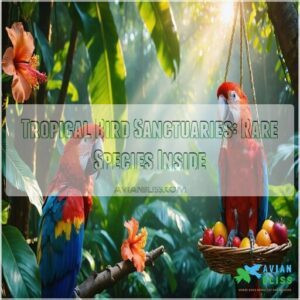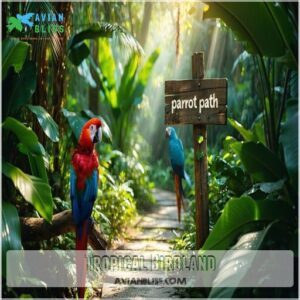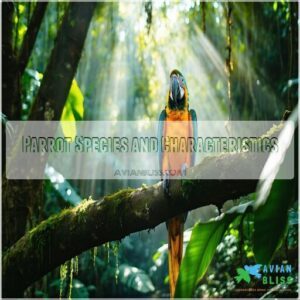This site is supported by our readers. We may earn a commission, at no cost to you, if you purchase through links.
 You’ll discover tropical bird sanctuaries dotting America’s coastlines, from Hudson, Florida to Del Mar, California, where colorful macaws and toucans find their second chance at life.
You’ll discover tropical bird sanctuaries dotting America’s coastlines, from Hudson, Florida to Del Mar, California, where colorful macaws and toucans find their second chance at life.
These havens aren’t just ordinary shelters – they’re specialized care centers where dedicated teams work tirelessly to protect and rehabilitate exotic birds.
While most operate by appointment only, they offer much more than basic housing, including custom nutrition plans, enrichment activities, and expert veterinary care.
Behind the scenes, passionate volunteers and staff tackle daily challenges to guarantee these magnificent creatures don’t just survive, but thrive in their new homes.
Table Of Contents
- Key Takeaways
- Tropical Bird Basics
- Bird Sanctuary Locations
- Sanctuary Operations
- Bird Species and Care
- Supporting Tropical Sanctuaries
- Frequently Asked Questions (FAQs)
- What is the Florida exotic bird sanctuary?
- What is a bird sanctuary?
- Why should you visit a tropical bird sanctuary?
- What is Greyhaven exotic bird sanctuary?
- What can you do at Tropical Birdland?
- Who is happy wings sanctuary?
- Which is the best bird sanctuary in the world?
- Where is the largest bird sanctuary in the US?
- What country has the most tropical birds?
- How much does it cost to visit the World Bird Sanctuary?
- Conclusion
Key Takeaways
- You’ll find tropical bird sanctuaries along America’s coastlines, from Hudson, Florida to Del Mar, California, where colorful macaws and toucans get a second chance at life, and you can visit them to learn about conservation efforts.
- These sanctuaries aren’t just shelters – they’re specialized care centers that provide custom nutrition plans, enrichment activities, and expert veterinary care to protect and rehabilitate exotic birds, and you can support them through donations or volunteering.
- You can get involved with tropical bird sanctuaries by donating, becoming a member, or volunteering, which will help fund essential care, habitat expansion, and community education programs that guarantee these birds thrive for generations to come.
- By supporting tropical bird sanctuaries, you’ll be contributing to the preservation of unique ecosystems, ensuring the beauty of these sanctuaries for years to come, and making a difference in the lives of incredible creatures like parrots, macaws, and toucans, one bird at a time.
Tropical Bird Basics
Understanding the basics is crucial for your journey into the world of tropical birds.
As you start your exploration, you’ll learn about these amazing creatures, their unique characteristics, habitats, and diets, which will help you appreciate the importance of conserving and protecting them.
Definition and Characteristics
You’re exploring tropical birds’ definition and characteristics.
These exotic species thrive in sanctuaries, showcasing vibrant plumage and unique traits.
They highlight the importance of conservation efforts in tropical bird sanctuaries for avian sanctuary and exotic bird conservation.
Habitat and Distribution
You’ll often find tropical bird species in forest ecosystems within specific climate zones.
Their geographic range spans various natural habitats, with some exhibiting migration patterns.
Habitat loss affects tropical bird habitats, impacting tropical ecosystems and bird migration, threatening tropical bird species’ survival, which is a significant concern due to habitat loss.
Diet and Nutrition
When considering feeding your tropical birds, it’s important to provide a balanced diet that meets their unique nutrient needs.
A variety of food sources, including fruits, vegetables, and pellets, can guarantee your birds receive the ideal nutrients for their health.
Understanding basic avian nutrition fundamentals is important for responsible bird ownership.
It’s important to consult with a veterinarian to create a customized dietary plan for your feathered friends, ensuring they receive the best possible care for their overall health.
Conservation Status
You’re now considering the conservation status of tropical birds.
Sadly, many are endangered due to habitat loss, threatening their survival.
Toucans, known for their large bills, are among the many fascinating tropical bird species.
Conservation efforts, like bird protection and wildlife preservation, are imperative to save these species, focusing on endangered birds and avian conservation to guarantee species preservation and wildlife conservation.
Bird Sanctuary Locations
You’ll find some of America’s most remarkable tropical bird sanctuaries along the coasts, where rescued parrots and exotic birds receive expert care in specialized facilities.
You can visit these havens in Hudson, Florida, Del Mar, California, and Summerland, California, where dedicated teams work to protect and rehabilitate rare species, and provide them with the care they need to thrive in specialized facilities.
Florida Exotic Bird Sanctuary
The Florida Exotic Bird Sanctuary in Hudson stands as a haven for over 1,200 parrots and exotic species.
You’ll find this tropical bird sanctuary expanding its 3.5-acre facility to accommodate 2,000 birds by 2030.
Through dedicated sanctuary management and conservation efforts, they’re transforming lives of formerly abused and neglected parrots.
Their bird adoption program carefully matches these incredible creatures with forever homes while prioritizing avian research and education.
Similar conservation efforts can be seen at Tropical Birdland facilities.
Free Flight Exotic Bird Sanctuary
While parrots soar freely at Del Mar’s Free Flight Exotic Bird Sanctuary, you’ll witness firsthand how proper sanctuary management transforms lives.
You’ll find dedicated avian health specialists monitoring flight patterns and bird behavior daily.
This tropical bird sanctuary excels in conservation efforts, providing second chances to unwanted parrots.
Through their work, they’re creating a haven where exotic birds thrive and inspire visitors to support bird conservation.
Santa Barbara Bird Sanctuary
Just a stone’s throw from the Pacific Ocean, you’ll find the Santa Barbara Bird Sanctuary in Summerland, California.
This tropical bird rescue provides a forever home to over 50 rescued parrots.
- Visit their lush tropical gardens at 2430 Lillie Avenue
- Meet rehabilitated macaws, cockatoos, and other exotic birds
- Learn about avian therapy and conservation efforts
- Support parrot rescue through admission fees
- Discover bird adoption opportunities for suitable homes
Tropical Birdland
While Santa Barbara Bird Sanctuary focuses on companion parrots, Tropical Birdland offers a completely different bird watching experience.
You’ll discover a nature lover’s paradise with its unique parrot path and woodland walk.
This wildlife sanctuary specializes in conservation of endangered tropical birds, making it a prime spot for bird tourism.
Their changing café menu keeps visitors energized for eco conservation activities throughout the tropical gardens.
Sanctuary Operations
You’ll find tropical bird sanctuaries running on a mix of volunteer dedication and careful funding strategies to meet the growing needs of their feathered residents.
These specialized facilities operate by appointment only, with small part-time staffs and volunteer boards who manage everything from rescue operations to educational outreach programs.
Facility Expansion Projects
Now that you’ve seen where these sanctuaries are located, let’s look at their growth. The facility expansion projects at tropical bird sanctuaries are taking flight!
Many top bird sanctuary locations are expanding. You’ll find 33 large indoor aviaries with attached outdoor spaces under construction, giving tropical birds fresh air and freedom.
Bird sanctuaries across the country are deepening research and expanding conservation efforts throughout 2024-2025, creating more space for our feathered friends.
Funding Requirements and Challenges
The financial heartbeat of tropical bird sanctuaries faces constant challenges.
You’ll find these havens need about $500,000 in matching funds for expansion projects like Phase II at Florida Exotic Bird Sanctuary.
Funding requirements cover not just housing more birds, but their daily care—food, medical expenses, and enrichment activities.
Donations and fundraising strategies become important for financial sustainability, especially as bird populations grow from hundreds to thousands.
Understanding exotic bird sanctuary costs is essential for effective budget planning and financial sustainability, which involves managing daily care expenses.
Volunteer and Donor Involvement
While funding challenges persist, tropical bird sanctuaries thrive through dedicated people like you.
Volunteer roles range from daily care to fundraising events – becoming the lifeline these magnificent birds depend on.
Your donations directly support medical care, food, and habitat improvements.
Many sanctuaries offer bird sponsorship options, connecting you with specific residents.
Even small contributions make a difference, and volunteers often say they receive more than they give.
Community Engagement and Education
While bird sanctuaries preserve exotic species, they also connect with their communities through thoughtful education programs.
You’ll find these sanctuaries actively engaging visitors through:
- Bird watching tours where you’ll observe rare tropical species in carefully designed habitats
- Volunteer training sessions that teach proper bird handling and care techniques
- Educational workshops where children and adults learn about conservation challenges
These public outreach efforts create passionate bird advocates in every community, promoting a deeper understanding of the importance of exotic species preservation.
Bird Species and Care
You’ll discover a remarkable array of birds at our sanctuaries, from vibrant Golden Pheasants to intelligent parrots that can live up to 80 years.
Each rescued bird receives specialized care customized to their unique needs, with dedicated staff monitoring their diets, medical requirements, and social well-being to guarantee they thrive in their new home, providing them with the opportunity to live a long and healthy life, similar to their natural habitats.
Parrot Species and Characteristics
Parrot’s remarkable intelligence shines through their ability to mimic human speech and solve complex puzzles.
You can find more information on various parrot species.
Their feather care and beak health require specialized attention from dedicated caregivers. You’ll find these fascinating creatures displaying vibrant color patterns and distinct personalities in sanctuaries worldwide.
| Characteristic | Detail | Natural Habitat | Lifespan |
|---|---|---|---|
| Size | 3.5-4 lbs | Tropical forests | Up to 80 years |
| Diet | Omnivorous | Warm climates | Daily care needed |
| Intelligence | Problem-solving | Social groups | Continuous learning |
| Care Needs | High maintenance | Community-based | Daily interaction |
They have a long lifespan of up to 80 years, and their diet is omnivorous, requiring daily care and interaction.
Other Exotic Bird Species
Soaring through tropical sanctuaries, you’ll discover an array of magnificent exotic birds beyond parrots.
These feathered wonders showcase nature’s diversity through unique wing structures and vibrant feather care needs.
- Macaws dazzle with their rainbow plumage and intelligent bird behavior
- Toucans charm visitors with their oversized beaks and playful personalities
- Majestic hornbills display distinctive head casques for enhanced beak health
- Tiny hummingbirds demonstrate remarkable flight abilities in avian conservation programs
The variety of birds, including unique wing structures, contributes to the richness of these tropical sanctuaries.
Rehabilitation and Rescue Efforts
Beyond rare species display, these sanctuaries provide critical second chances. When you visit Florida Exotic Bird Sanctuary, you’ll witness firsthand how bird rehabilitation transforms neglected parrots into thriving residents.
Wildlife rehab centers treat over 650 injured birds annually, focusing on emergency care and avian therapy.
Properly caring for injured birds involves creating a safe, stress-free environment.
Sanctuaries don’t just heal physical wounds—they help birds re-socialize, creating positive environments where even the most traumatized parrots can find their voices again, which is a critical part of their rehabilitation.
Ongoing Care and Protection
After rescue comes the ongoing work. You’ll find sanctuaries providing daily Bird Nutrition plans customized to each species.
Veterinary Care happens regularly, with staff monitoring for subtle health changes. Habitat Maintenance isn’t just cleaning—it’s creating environments where birds thrive mentally and physically.
Medical Treatment protocols exist for everything from minor injuries to complex surgeries. Emergency Response teams stand ready 24/7, ensuring every feathered resident receives the protection they deserve, regardless of species or circumstance.
The sanctuaries also focus on providing essential bird food supplements to support the health of the birds.
Supporting Tropical Sanctuaries
You’ll help save endangered tropical birds by supporting sanctuaries with donations, memberships, or your time as a volunteer.
Your contribution directly funds essential care, habitat expansion, and community education programs that guarantee these colorful creatures thrive for generations to come, which is crucial for their survival and generations to come.
Donation Options and Benefits
Your gift to a bird sanctuary transforms lives – both feathered and human.
Through various donation levels, you’ll help provide food, medical care, and enrichment activities.
Tax-deductible donations provide donor rewards like sanctuary visits and exclusive fundraising events.
You can even sponsor a specific bird’s journey to recovery. Your giving back helps these magnificent creatures spread their wings and thrive.
By supporting conservation efforts, you contribute to global bird conservation efforts that protect endangered species and their habitats, which is a crucial part of bird conservation and helps in the recovery of these species.
Membership and Sponsorship Programs
You’ll find plenty of ways to support our feathered friends through membership and sponsorship programs.
Here’s what you’ll receive when you join:
- Monthly behind-the-scenes sanctuary updates and photos
- VIP access to special bird-watching events
- Recognition on our donor wall of flight
- Exclusive bird adoption opportunities
Your membership directly funds our conservation efforts, providing food, shelter, and care for these magnificent creatures.
Call us to explore sponsorship levels that match your goals.
Volunteer Opportunities and Roles
Stepping into volunteer work at a bird sanctuary opens doors to meaningful conservation roles. You’ll find diverse opportunities, from hands-on bird care tasks like feeding and habitat maintenance to sanctuary management duties.
Whether you’re cleaning aviaries, preparing enrichment activities, or assisting with community outreach, your time makes a difference.
Parrot rescue volunteers often develop special bonds with these intelligent creatures while supporting their rehabilitation journey.
Spreading Awareness and Education
Local bird advocates share their passion through education outreach and community events.
You’ll discover how to support wildlife conservation through interactive workshops, bird watching tours, and environmental education programs.
Join sanctuary experts to learn about tropical birds’ unique behaviors and care needs.
Your involvement helps raise public awareness about these magnificent creatures while fostering a deeper appreciation for bird sanctuaries’ essential conservation work.
Frequently Asked Questions (FAQs)
What is the Florida exotic bird sanctuary?
You’ll discover the Florida Exotic Bird Sanctuary, a haven providing care, rehabilitation, and a forever home for exotic birds, prioritizing their welfare, education, and conservation with love and dedication always.
What is a bird sanctuary?
You’ll learn that a bird sanctuary is a safe haven providing care, protection, and conservation for various bird species, promoting their welfare and educating the public about these amazing creatures.
Why should you visit a tropical bird sanctuary?
You’ll experience vibrant species, gain insight into conservation, and support a safe haven for magnificent birds, fostering a deeper connection with nature and its incredible creatures, while having fun.
What is Greyhaven exotic bird sanctuary?
You’re a key to opening a haven for exotic birds.
Greyhaven sanctuary provides rescue, rehabilitation, and a forever home for parrots and other species in need of love and care always.
rescue, rehabilitation, and a forever home
What can you do at Tropical Birdland?
You can explore a parrot path, woodland walk, and cafe at Tropical Birdland, engaging with conservation efforts and endangered species in a unique, nature-lover’s wonderland setting, with various activities.
Who is happy wings sanctuary?
You’re a puzzle piece, and Happy Wings Sanctuary is a haven for rescued parrots, providing love, care, and a forever home for these vibrant birds.
Filling their lives with joy and freedom.
Which is the best bird sanctuary in the world?
You’ll find the best bird sanctuary by researching ones with excellent care, conservation, and education, like the Florida Exotic Bird Sanctuary or Free Flight Exotic Bird Sanctuary, prioritizing bird welfare.
Where is the largest bird sanctuary in the US?
Imagine walking into a vibrant aviary, you’ll find the largest US bird sanctuary in Florida, covering 5 acres, providing a safe haven for over 1,200 exotic birds.
What country has the most tropical birds?
You’ll discover that Brazil has the most tropical birds, boasting over 1,800 species, due to its vast Amazon rainforest and unique geography.
How much does it cost to visit the World Bird Sanctuary?
You’ll need to check the World Bird Sanctuary’s website or call them, as admission prices vary, and they offer different packages and membership options for visitors.
Conclusion
As the saying goes, "every bird counts," you can make a difference by supporting tropical bird sanctuaries, which provide a safe haven for rare species to thrive.
By getting involved with these specialized care centers, you’ll be helping to protect and rehabilitate exotic birds, ultimately preserving the beauty of tropical bird sanctuaries for generations to come.
One bird at a time, your support will contribute to the preservation of these unique ecosystems, ensuring the beauty of tropical bird sanctuaries for years to come, and making a difference in the lives of these incredible creatures, one bird at a time.














